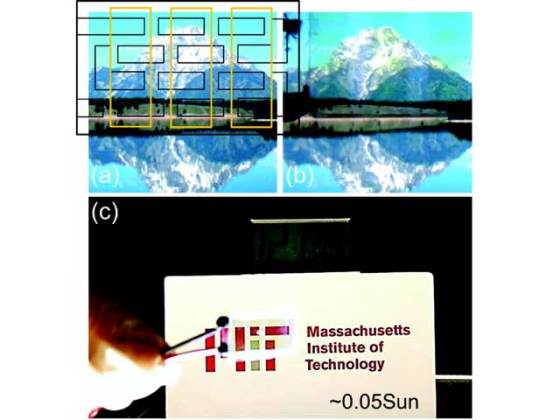MIT researchers developing organic transparent solar cells
 A group of researchers from MIT develops a photovoltaic cell based on organic molecules, which harnesses the energy of infrared light while allowing visible light to pass through, thus enabling power generation in transparent. Coated onto a pane of standard window glass, it could provide power for lights and other devices, and would lower installation costs by taking advantage of existing window structures.
A group of researchers from MIT develops a photovoltaic cell based on organic molecules, which harnesses the energy of infrared light while allowing visible light to pass through, thus enabling power generation in transparent. Coated onto a pane of standard window glass, it could provide power for lights and other devices, and would lower installation costs by taking advantage of existing window structures.
Previous attempts to create transparent solar cells have either had extremely low efficiency (less than 1 percent of incoming solar radiation is converted to electricity), or have blocked too much light to be practical for use in windows. But Vladimir Bulović, professor of electrical engineering in the Department of Electrical Engineering and Computer Science, and Richard Lunt, a postdoctoral researcher in the Research Laboratory of Electronics, were able to find a specific chemical formulation for their cells that, when combined with partially infrared-reflective coatings, gives both high visible-light transparency and much better efficiency than earlier versions (comparable to that of non-transparent organic photovoltaic cells).
In a new building, or one where windows are being replaced anyway, adding the transparent solar cell material to the glass would be a relatively small incremental cost, since the cost of the glass, frames and installation would all be the same with or without the solar component, although it is too early in the process to be able to estimate actual costs. And with modern double-pane windows, the photovoltaic material could be coated on one of the inner surfaces, where it would be completely protected from weather or window washing. Only wiring connections to the window and a voltage controller would be needed to complete the system in a home.
In addition, much of the cost of existing solar panels comes from the glass substrate that the cells are placed on, and from the handling of that glass in the factory. Again, much of that cost would not apply if the process were made part of an existing window-manufacturing operation. So far, they have achieved an efficiency of 1.7 percent in the prototype solar cells, but they expect that with further development they should be able to reach 12 percent, making it comparable to existing commercial solar panels.
The researchers expect that after further development in the lab followed by work on manufacturability, the technology could become a practical commercial product within a decade. In addition to being suitable for coating directly on glass in the manufacture of new windows, the researchers claim that the material might also be coated onto flexible material that could then be rolled onto existing windows.
Using the window surfaces of existing buildings could provide much more surface area for solar power than traditional solar panels, Bulović says. In mornings and evenings, with the sun low in the sky, the sides of big-city buildings are brightly illuminated, he says, and that vertical “footprint” of potential light-harvesting area could produce a significant amount of power.
The researchers claim the installations of the new system would also block much of the heating effect of sunlight streaming through the windows, potentially cutting down on air conditioning needs within a building. Another benefit is the manufacturing process for this kind of solar cells which is more environmentally friendly, since it requires less energy compared to creation of silicon solar cells. However, there is the question of durability of organic photovoltaic cells, which would be of great importance if this technology would be used between window layers.
For more information, read the article published in the journal Applied Physics Letters named: “Transparent, near-infrared organic photovoltaic solar cells for window and energy-scavenging applications“










Wonderful research on solar cells by MIT. Congratulations.
Dr.A.Jagadeesh Nellore(AP),India
It is looking great invention of solar cells. Congrats MIT.